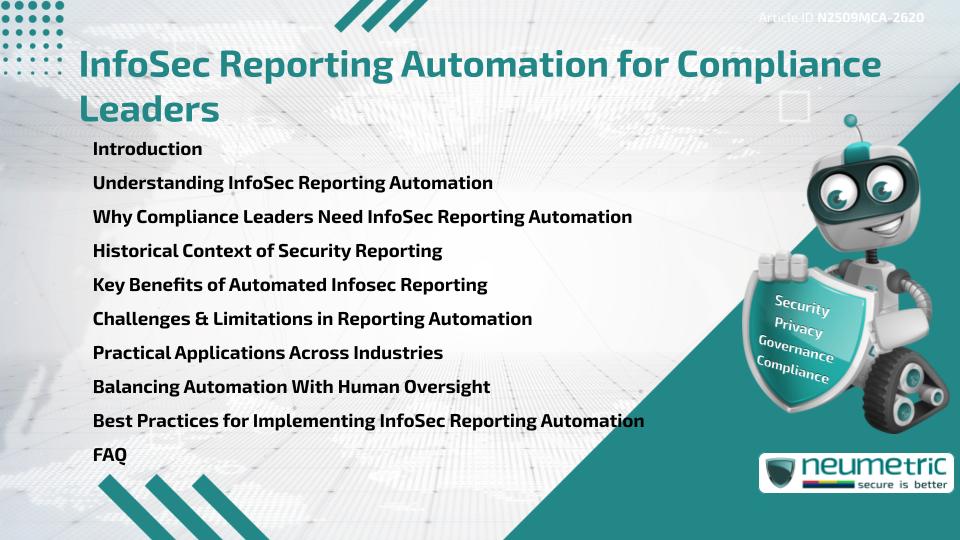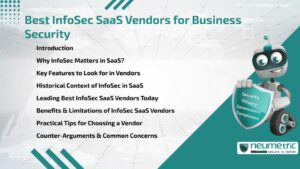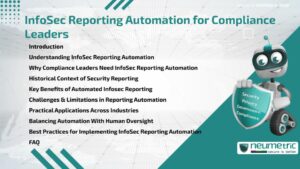Table of Contents
ToggleIntroduction
InfoSec Reporting Automation is transforming how Compliance Leaders manage Security documentation, streamline processes & meet regulatory requirements. By automating data collection, analysis & reporting, Organisations reduce manual effort while ensuring accuracy & timeliness. This approach addresses common challenges such as human error, Audit fatigue & increasing Compliance demands. Compliance leaders rely on InfoSec Reporting Automation to balance efficiency with accountability, ensuring that Information Security practices remain aligned with Regulatory Standards & business goals.
Understanding InfoSec Reporting Automation
At its core, InfoSec Reporting Automation refers to using software tools & structured workflows to generate Compliance & security reports without relying heavily on manual input. These reports may cover Vulnerability management, Incident Response metrics or regulatory checklists. Instead of gathering information from scattered sources, automation centralizes the process, much like an autopilot system in aviation ensures consistent performance with minimal manual intervention.
Why Compliance Leaders Need InfoSec Reporting Automation
Compliance leaders oversee complex Frameworks such as SOC 2, ISO 27001, HIPAA & GDPR. Each Framework has unique reporting requirements that can quickly overwhelm teams if handled manually. InfoSec Reporting Automation ensures these obligations are met consistently. For example, an automated system can generate an Access Control report in minutes, reducing what would otherwise take hours. This efficiency allows leaders to focus more on strategic decision-making rather than administrative burdens.
Historical Context of Security Reporting
Traditionally, Information Security reporting relied heavily on spreadsheets, emails & manual Audits. While functional, these methods often led to delays, inconsistent data & incomplete records. Over time, as regulations became more complex, manual methods proved insufficient. The shift toward automation mirrors historical changes in industries such as accounting, where automated systems replaced hand-written ledgers for greater accuracy & reliability.
Key Benefits of Automated Infosec Reporting
Automated reporting brings several advantages to Organisations, including:
- Accuracy: Reduced Risk of errors caused by manual entry.
- Speed: Faster turnaround for Audits & Stakeholder reviews.
- Consistency: Uniform reporting formats across multiple Compliance Frameworks.
- Scalability: Easier to expand reporting as Organisations grow.
- Audit readiness: Improved ability to provide on-demand Evidence for regulators.
In effect, InfoSec Reporting Automation functions like a translator, turning raw data into standardised outputs that Auditors & regulators can readily understand.
Challenges & Limitations in Reporting Automation
Despite its benefits, automation is not without challenges. Some Organisations struggle with high upfront costs for new tools or face integration issues with legacy systems. Additionally, automated systems can produce errors if the input data is flawed. Overreliance on automation without periodic human oversight can also lead to gaps, especially when unique exceptions or nuanced judgments are required. These limitations highlight the importance of using automation as a support mechanism rather than a complete replacement for human review.
Practical Applications Across Industries
Different industries benefit from InfoSec Reporting Automation in distinct ways. In Healthcare, it streamlines reporting for Patient Data protections under HIPAA. In Finance, it supports Continuous Monitoring for SOX & PCI-DSS Compliance. In technology, startups & enterprises alike use it to maintain security Certifications that build trust with Customers. The universality of automation demonstrates its adaptability across multiple regulatory environments.
Balancing Automation With Human Oversight
While automation offers clear efficiencies, human oversight remains critical. Compliance leaders must validate reports, interpret anomalies & ensure context is not lost in standardised outputs. Much like a pilot monitors autopilot systems, leaders play an essential role in balancing automation with judgment. This combination ensures that InfoSec Reporting Automation enhances decision-making without diminishing accountability.
Best Practices for Implementing InfoSec Reporting Automation
For Organisations looking to adopt InfoSec Reporting Automation effectively, several Best Practices stand out:
- Start small with high-impact reports before scaling further.
- Ensure tools integrate seamlessly with existing systems.
- Maintain regular Audits of both input data & automated outputs.
- Train teams to interpret automated reports critically.
- Balance cost considerations with long-term efficiency gains.
By following these steps, Compliance Leaders can maximize the benefits while minimizing Risks.
Takeaways
InfoSec Reporting Automation equips Compliance Leaders with the tools to streamline reporting, reduce errors & stay Audit-ready. However, automation must be paired with human oversight to ensure accuracy & accountability. When used wisely, it not only saves time but also strengthens organizational trust & Compliance posture.
FAQ
What is InfoSec Reporting Automation?
It is the use of automated tools & workflows to generate Compliance & security reports with minimal manual effort.
How does InfoSec Reporting Automation benefit Compliance Leaders?
It saves time, reduces errors, improves consistency & ensures Organisations remain Audit-ready.
Can InfoSec Reporting Automation replace human Auditors?
No, it complements human oversight by handling repetitive tasks while Auditors provide interpretation & judgment.
Which industries benefit most from InfoSec Reporting Automation?
Industries such as Healthcare, Finance & technology see strong benefits due to strict regulatory Frameworks.
What challenges come with InfoSec Reporting Automation?
High costs, integration issues & the Risk of overreliance without human oversight are common challenges.
Is InfoSec Reporting Automation suitable for Small Businesses?
Yes, many scalable solutions exist that cater to smaller Organisations without large Compliance teams.
How do Organisations ensure accurate automated reports?
By validating input data, maintaining oversight & conducting regular Audits of automated outputs.
References
Need help for Security, Privacy, Governance & VAPT?
Neumetric provides organisations the necessary help to achieve their Cybersecurity, Compliance, Governance, Privacy, Certifications & Pentesting needs.
Organisations & Businesses, specifically those which provide SaaS & AI Solutions in the Fintech, BFSI & other regulated sectors, usually need a Cybersecurity Partner for meeting & maintaining the ongoing Security & Privacy needs & requirements of their Enterprise Clients & Privacy conscious Customers.
SOC 2, ISO 27001, ISO 42001, NIST, HIPAA, HECVAT, EU GDPR are some of the Frameworks that are served by Fusion – a SaaS, multimodular, multitenant, centralised, automated, Cybersecurity & Compliance Management system.
Neumetric also provides Expert Services for technical security which covers VAPT for Web Applications, APIs, iOS & Android Mobile Apps, Security Testing for AWS & other Cloud Environments & Cloud Infrastructure & other similar scopes.
Reach out to us by Email or filling out the Contact Form…





